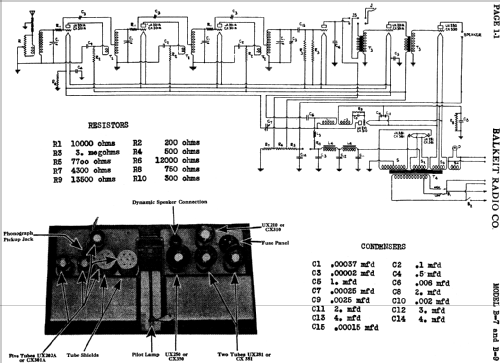Balkeit Symphion B7
Fansteel Products (Pfanstiehl, Pfansteihl, Balkite, Balkeit); Chicago
- Pays
- Etats-Unis
- Fabricant / Marque
- Fansteel Products (Pfanstiehl, Pfansteihl, Balkite, Balkeit); Chicago
- Année
- 1928
- Catégorie
- Radio - ou tuner d'après la guerre 1939-45
- Radiomuseum.org ID
- 33973
-
- alternative name: Balkeit || First National
- Brand: Overtone
Cliquez sur la vignette du schéma pour le demander en tant que document gratuit.
- No. de tubes
- 9
- Principe général
- Récepteur TRF - sans réaction (pas régénératif); Neutrodyne
- Circuits accordés
- 4 Circuits MA (AM)
- Gammes d'ondes
- PO uniquement
- Tension / type courant
- Alimentation Courant Alternatif (CA) / 115 Volt
- Haut-parleur
- HP mais de technologie inconnue
- Matière
- Boitier en bois
- De Radiomuseum.org
- Modèle: Balkeit Symphion B7 - Fansteel Products Pfanstiehl,
- Forme
- Console de forme générique
- Remarques
- Balkeit, Balkite, Pfanstiehl are put together to Fansteel. One dial (primary tuning control knob).
The Symphion models employ a UX210 tube as an oscillator at about 3000 kHz, to supply the filaments of the five 201As ! Thus avoiding hum and permitting use of the 201A (which is considered superior) in an electric set.
- Prix de mise sur le marché
- 475.00 $
- Source extérieure
- Ernst Erb
- Source du schéma
- Rider's Perpetual, Volume 1 = 1931/1934 (for 1919-1931)
- Littérature
- Collector's Guide to Antique Radios 4. Edition
- Schémathèque (1)
- Radio Manufacturers of the 1920's, Vol. 2
- D'autres Modèles
-
Vous pourrez trouver sous ce lien 131 modèles d'appareils, 74 avec des images et 61 avec des schémas.
Tous les appareils de Fansteel Products (Pfanstiehl, Pfansteihl, Balkite, Balkeit); Chicago
Contributions du forum pour ce modèle: Fansteel Products: Balkeit Symphion B7
Discussions: 1 | Publications: 1
Um einerseits die direkt geheizten Trioden UX201A ohne Netzbrumm verwenden zu können, kam man hier (und auch beim Modell B9) auf die Idee, mit Hochfrequenz zu heizen. Vorteil: das Gerät ist sofort betriebsbereit, und der Wiedergabe-Frequenzbereich ließ sich ausweiten, vor allem nach unten..
Als Frequenz wurde etwa 3 MHz gewählt, somit weit über dem Rundfunkband gelegen. Eine rückgekoppelte UX210A die bei 12 W maximaler Anodenverlustleistung normalerweise nur 1,6 W Sprechleistung bringt, macht voll durchgesteuert (Klirrfaktor ist egal) gerade schön die erforderlichen 6,25 W für die fünf UX201A (je 5V / 0,25 A).
Diese Neutrodyne-Vierkreiser waren bald überholt durch bessere Röhren mit indirekter Heizung, durch Schirmgitterröhren und schließlich durch die aufkommenden Superhets.
Konrad Birkner † 12.08.2014, 07.Sep.09
